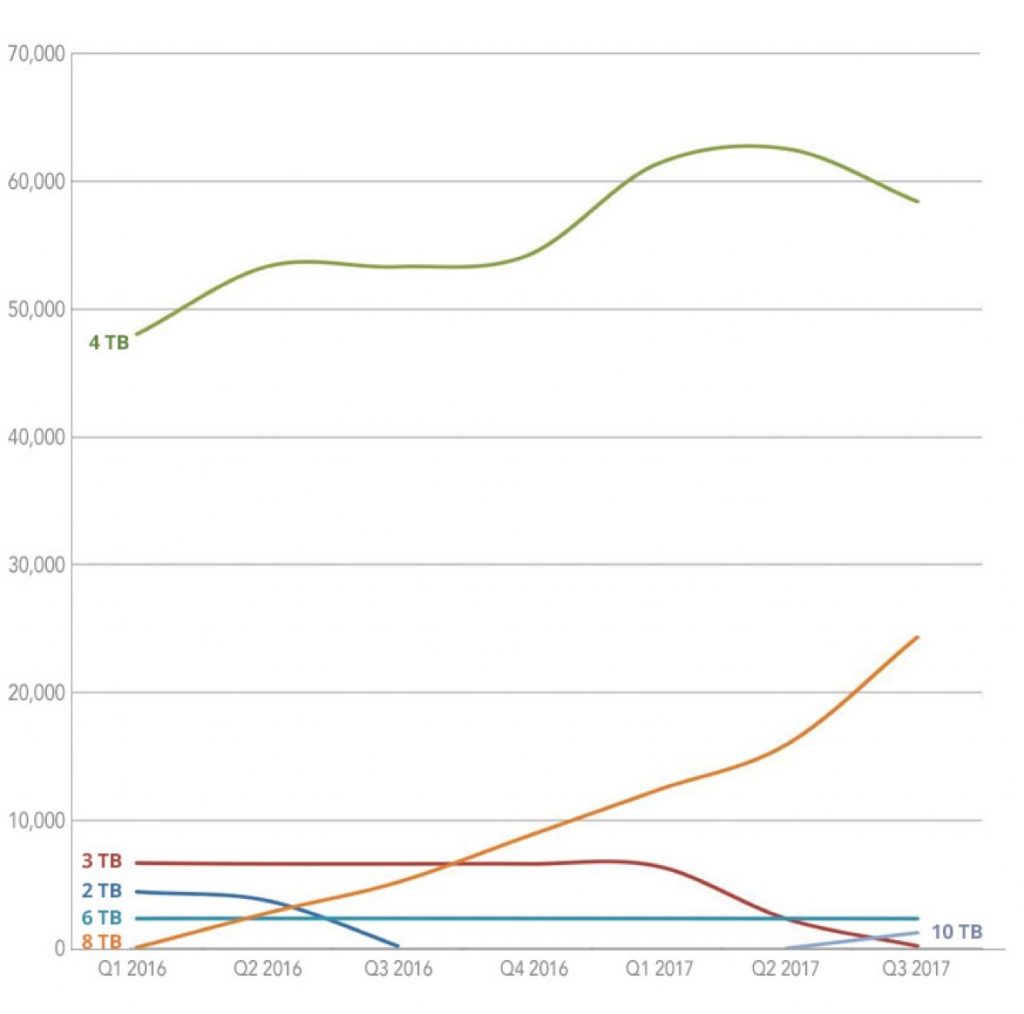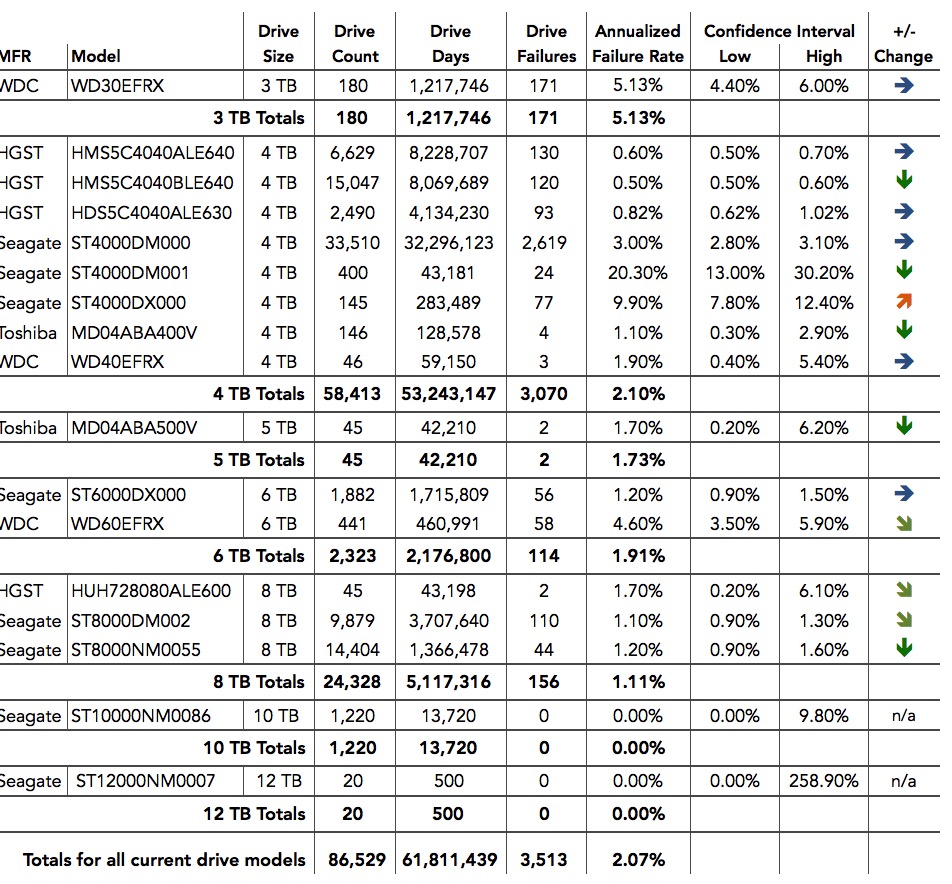Backblaze HDD Stats for 3Q17
Zero failure for 1,240 10TB and 12TB drives recently added
This is a Press Release edited by StorageNewsletter.com on October 31, 2017 at 2:48 pm This paper, HDD Stats for Q3 2017, was written of the blog of Backblaze, Inc. by Andy Klein, director of product marketing, on October 26, 2017
This paper, HDD Stats for Q3 2017, was written of the blog of Backblaze, Inc. by Andy Klein, director of product marketing, on October 26, 2017
In Q3 2017, Backblaze introduced both 10TB and 12TB HDDs into our data centers, we continued to retire 3TB and 4TB HDDs to increase storage density, and we added over 59PB of storage to bring our total storage capacity to 400PB.
In this update, we’ll review the Q3 2017 and lifetime HDD failure rates for all our drive models in use at the end of Q3. We’ll also check in on our 8TB enterprise versus consumer HDD comparison, and look at the storage density changes in our data centers over the past couple of years. Along the way, we’ll share our observations and insights, and as always, you can download the HDD statistics data we use to create these reports.
Q3 2017 HDD Failure Rates
Since our Q2 2017 report, we added 9,599 new HDDs and retired 6,221 HDDs, for a net add of 3,378 drives and a total of 86,529. These numbers are for those HDDs of which we have 45 or more drives – with one exception that we’ll get to in a minute.
Let’s look at the Q3 statistics that include our first look at the 10TB and 12TB HDDs we added in Q3. The chart below is for activity that occurred just in Q3 2017.
HDDs failure rates for 3Q17
Observation period: July 1, 2017 – September 30, 2017

Observations
- The HDD failure rate for the quarter was 1.84%, our lowest quarterly rate ever. There are several factors that contribute to this, but one that stands out is the average age of the HDDs in use. Only the 4TB HGST drives (model: HDS5C4040ALE630) have an average age over 4 years – 51.3 months to be precise. The average age of all the other drive models is less than 4 years, with nearly 80% of all of the drives being less than 3 years old.
- The 10TB and 12TB drive models are new. With a combined 13,000 drive days in operation, they’ve had zero failures. While all of these drives passed through formatting and load testing without incident, it is a little too early to reach any conclusions.
Testing Drives
Normally, we list only those drive models where we have 45 drives or more, as it formerly took 45 drives (currently 60), to fill a Storage Pod. We consider a Storage Pod as a base unit for drive testing. Yet, we listed the 12TB drives even though we only have 20 of them in operation. What gives? It’s the first step in testing drives.
A Backblaze Vault consists of 20 Storage Pods logically grouped together. Twenty 12TB drives are deployed in the same drive position in each of the 20 Storage Pods and grouped together into a storage unit we call a ‘tome.’ An incoming file is stored in one tome, and is spread out across the 20 storage pods in the tome for reliability and availability. The remaining 59 tomes, in this case, use 8TB drives. This allows us to see the performance and reliability of a 12TB HDD model in an operational environment without having to buy 1,200 of them to start.
Breaking news: Our first Backblaze Vault filled with 1,200 Seagate 12TB HDDs (model: ST12000NM007) went into production on October 20th.
Storage Density Continues to Increase
As noted earlier, we retired 6,221 HDDs in Q3: all 3TB or 4TB HDDs. The retired drives have been replaced by 8TB, 10TB and 12TB drive models. This dramatic increase in storage density added 59PB of storage in Q3. The following chart shows that change since the beginning of 2016.
HDD count per drive size
In Backblaze data centers from 1Q16 to 3Q17

You clearly can see the retirement of the 2TB and 3TB drives, each being replaced predominantly by 8TB drives. You also can see the beginning of the retirement curve for the 4 TB drives that will be replaced most likely by 12TB drives over the coming months. A subset of the 4TB drives, about 10,000 or so which were installed in the past year or so, will most likely stay in service for at least the next couple of years.
Lifetime HDD Stats
The table below shows the failure rates for the HDD models we had in service as of September 30, 2017. This is over the period beginning in April 2013 and ending September 30, 2017. If you are interested in the HDD failure rates for all the HDDs we’ve used over the years, please refer to our 2016 HDD review.
Cumulative HDD failure rates
Observation period: April 2013 – September 2017

Note 1: The ‘+ / – Change’ column reflects the change in the annualized failure rate from the previous quarter. Down is good, up is bad.
Note 2: You can download the data on this chart and the data from the ‘HDD Failure Rates for Q3 2017’ chart shown earlier in this review. The downloaded ZIP file contains one MSExcel spreadsheet.
The annualized failure rate for all of the drive models listed above is 2.07%; this is the higher than the 1.97% for the previous quarter. The primary driver behind this was the retirement of all of the HGST 3TB drives (model: HDS5C3030ALA630) in Q3. Those drives had over 6 million drive days and an annualized failure rate of 0.82% – well below the average for the entire set of drives. Those drives now are gone and no longer part of the results.
Consumer Vs. Enterprise Drives
The comparison of the consumer and enterprise Seagate 8TB drives continues. Both of the drive models, enterprise: ST8000NM0055 and consumer: ST8000DM002, saw their annualized failure rates decrease from the previous quarter. In the case of the enterprise drives, this occurred even though we added 8,350 new drives in Q3. This brings the total number of Seagate 8TB enterprise drives to 14,404, which have accumulated nearly 1.4 million drive days.
A comparison of the two drive models shows the annualized failure rates being very similar:
• 8TB Consumer Drives: 1.1% annualized failure rate
• 8TB Enterprise Drives: 1.2% annualized failure rate
Given that the failure rates for the two drive models appears to be similar, are the Seagate 8TB enterprise drives worth any premium you might have to pay for them? As we have previously documented, the Seagate enterprise drives load data faster and have a number of features such as the PowerChoice technology that can be very useful. In addition, enterprise drives typically have a 5-year warranty versus a 2-year warranty for the consumer drives. While drive price and availability are our primary considerations, you may decide other factors are more important.
We will continue to follow these drives, especially as they age over two years: the warranty point for the consumer drives.
Our next drive stats post will be in January, when we’ll review the data for Q4 and all of 2017, and we’ll update our lifetime stats for all of the drives we have ever used. In addition, we’ll get our first real look at the 12TB drives.













 Subscribe to our free daily newsletter
Subscribe to our free daily newsletter

